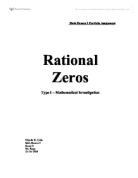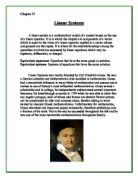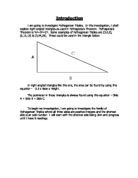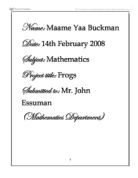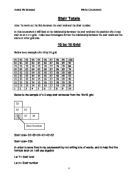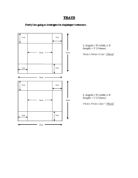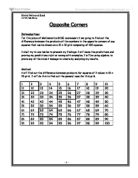Rational Zeros Portfolio Assignment
Math Honors 2 Portfolio Assignment Rational Zeros Type I - Mathematical Investigation Nicole K. Calo Math Honors 2 Block D Ms. Kopp 2/ 16/ 2008 INTRODUCTION This portfolio will be dealing briefly with the topic of rational zeros. In mathematics, a rational number is a number which can be expressed as a ratio of two integers. Non-integer rational numbers (commonly called fractions) are usually written as the basic fraction , where b = 0.i The zero of a polynomial is an input value (usually an x-value) that returns a value of zero for the whole polynomial when you plug it into the polynomial. When a zero is a real (that is, not complex) number, it is also an x-intercept of the graph of the polynomial function.ii Hence, a rational zero is a rational number that makes the entire polynomial equal to zero when it is substituted into the polynomial. Graphically, it is the x-value of the intersection point of the function f (x) and the line y = 0. OUTLINE In Part 1 of the portfolio, we will be graphing closely related function to discover the polynomials' relations to their graphs and their zeros. We will also try to spot certain patterns whilst not trying to form generalizations through them, but only for the purpose of observation. We cannot be sure yet at this stage that these apparent consistencies are of huge importance or simply nuisances, therefore we shall
Linear Systems
Chapter #1 Linear Systems A linear system is a mathematical model of a system based on the use of a linear operator. It is in which the outputs are components of a vector which is equal to the value of a linear operator applied to a vector whose components are the inputs. It is where all the interrelationships among the quantities involved are expressed by linear equations which may be algebraic, differential, or integral. Equivalent equations- Equations that have the same graph or solution. Equivalent systems- Systems of equations that have the same solution. Linear Systems was mostly founded by Carl Friedrich Gauss. He was a German scientist and mathematician who excelled in mathematics. Gauss had a remarkable influence in many fields of mathematics and science and is ranked as one of history's most influential mathematicians. Gauss earned a scholarship and in college, he independently rediscovered several important theorems; his breakthrough occurred in 1796 when he was able to show that any regular polygon, each of whose odd factors are distinct Fermat primes, can be constructed by ruler and compass alone, thereby adding to work started by classical Greek mathematicians. Unfortunately for mathematics, Gauss reworked and improved papers incessantly, therefore publishing only a fraction of his work. But in the end he succeeded throughout his life and he was one
Pythagorian Triples
Introduction I am going to investigate Pythagorean Triples. In this investigation, I shall explore right-angled triangles as used in Pythagoras's Theorem. Pythagoras's Theorem is 'A²+B²=C². Some examples of Pythagorean Triples are (3,4,5), (5,12,13) & (7,24,25). These could be used in the triangle below. In right-angled triangles like this one, the area can be found by using this equation - 0.5 x Base x Height. The perimeter in these triangles is always found using this equation - Side A + Side B + Side C. To begin my investigation, I am going to investigate the family of Pythagorean Triples where all three sides are positive integers and the shortest side is an odd number. I will start with the shortest side being 3cm and progress until I have 9 readings. 'B + 1' 3² + 4² = 5² (9+16=25) Area = 0.5 x 3 x 4 =6cm² Perimeter = 3cm + 4cm + 5cm = 12cm 5² + 12² = 13² (25+144=169) Area = 0.5 x 5 x 12 = 30cm² Perimeter= 5cm+12cm+13cm=30cm² 7²+24² = 25² (49+576 = 625) Area = 0.5 x 7 x 24 = 84cm² Perimeter= 7cm+24cm+25cm=56cm² 9²+40² = 41² (81+1600 = 1681) Area = 0.5 x 9 x 40 = 180cm² Perimeter = 9cm+40cm+41cm = 90cm 11²+60² = 61² (121+3600 = 3721) Area = 0.5 x 11 x 60 = 330cm² Perimeter = 11cm+60cm+61cm = 132cm 13²+84² = 85² (169+7056 = 7225) Area = 0.5 x 13 x 84 = 546cm² Perimeter = 13cm+84cm+85cm = 182cm 15²+112² = 113²
Frogs Investigation - look at your results and try to find a formula which gives the least number of moves needed for any number of discs x .It may help if you can count the number of hops and slides separately .
Name: Maame Yaa Buckman Date: 14th February 2008 Subject: Mathematics Project title: Frogs Submitted to: Mr. John Essuman (Mathematics Department) Content Page Introduction to frogs Page 3 Example of the game Page 4 Question 1 Pages 5&6 Question 2 Pages 7, 8&9 Question 3 Pages 10, 11, 12&13 Formula 1 Page 14 Question 4 Page 15 Question 5 Pages 16&17 Question 6 Pages 18, 19 &20 Question 7 Pages 21, 22, 23&24 Formula Page 25 Conclusion Page 26 This was a game invented by the French mathematician called Lucas .He named it Frogs. The Aim of The Game To gain success in this interesting game you need to swap the positions of the disc so that they end up the opposite way around. (With a space in the middle) The rules are as follows: . A disc can slide over one square in either direction onto an empty square. 2. A disc can hop over one adjacent disc of the other color provided it can land on an empty square. Take a look at this example A) Slide one square to the right. B) Hops over to the left. C) Slide one square to the right.
maxi products
GCSE Maths Coursework - Maxi Product Introduction In this investigation, I am going investigate the Maxi Product of numbers. I am going to find the Maxi Product for selected numbers and then work out a general rule after individual rules are worked out for each step. I am going to find the Maxi Product for double numbers, I will find two numbers which added together equal the number selected and when multiplied will equal the highest number possible that can be retrieved from two numbers multiplied together. I am also going to find the Maxi Product for triple numbers, I will find three numbers which added together equal the number selected and when multiplied will equal the highest number possible that can be retrieved from three number multiplied together. And finally, I am going to find the Maxi Product for quadruplet numbers, I will find four numbers which added together equal the number selected and when multiplied will equal the highest number possible that can be retrieved from four numbers multiplied together. After working out the individual rules for these three sectors of numbers, I will then work out the general rule for any amount of numbers it can be split into. For example, it can be split up into five numbers and I will be able to find the Maxi Product of any number given by splitting it up into five numbers. I will be using whole numbers, decimal numbers
Stair Totals coursework
Stair Totals Aim: To work out the link between the stair total and the Stair number. In this coursework I will look at the relationship between the stair total and the position of a 3 step stair on an n x n grid. I also must investigate further the relationship between the stair totals and the stairs on other grid size. 0 by 10 Grid Below is an example of a 10 by 10 grid 91 92 93 94 95 96 97 98 99 00 81 82 83 84 85 86 87 88 89 90 71 72 73 74 75 76 77 78 79 80 61 62 63 64 65 66 67 68 69 70 51 52 53 54 55 56 57 58 59 60 41 42 43 44 45 46 47 48 49 50 31 32 33 34 35 36 37 38 39 40 21 22 23 24 25 26 27 28 29 30 1 2 3 4 5 6 7 8 9 20 2 3 4 5 6 7 8 9 0 Below is the sample of a 3 step stair extracted from the 10x10 grid Stair total= 32+33+34+42+43+52 Stair total= 236 In order to save time in my coursework by not writing lots of words, and to help find the formula later on I will use algebra Let T= Stair total Let n= Stair number So by looking at the above diagram I can say that my T value is 236 and my n value is 32. I will begin by examining the number stairs beginning with n = 1. The reason why I am going to do this is because of the following; * It is simple and easy to work with * It is logical * It will help find the nth term later because I will be starting at the
opposite corners
Maths Coursework: Opposite Corners Opposite Corners: Introduction: My algebra coursework is about opposite corners in a square in a number grid. The top right and the bottom left numbers are multiplied and the same is done with the top left and bottom right numbers. The difference is calculated between the 2 products and the answer is used to find a pattern. The size of the square will be changed, 2x2, 3x3 and 4x4, to see whether the answers left will help to determine whether or not there is a pattern. 0x10 Grid: I am starting off by using a 10x10 and within this grid I will outline 2x2 squares, 3x3 squares and 4x4 squares. With these squares I will work out the opposite corners in order to see whether or not there is a pattern. 2 3 4 5 6 7 8 9 0 1 2 3 4 5 6 7 8 9 20 21 22 23 24 25 26 27 28 29 30 31 32 33 34 35 36 37 38 39 40 41 42 43 44 45 46 47 48 49 50 51 52 53 54 55 56 57 58 59 60 61 62 63 64 65 66 67 68 69 70 71 72 73 74 75 76 77 78 79 80 81 82 83 84 85 86 87 88 89 90 91 92 93 94 95 96 97 98 99 00 2x2 Squares: 2 3 4 5 6 7 8 9 0 1 2 3 4 5 6 7 8 9 20 21 22 23 24 25 26 27 28 29 30 31 32 33 34 35 36 37 38 39 40 41 42 43 44 45 46 47 48 49 50 51 52 53 54 55 56 57 58 59 60 61 62 63 64 65 66 67 68 69 70
Algebra Story
. Choose the type of problem you want to have. 4+4y=30 2. Choose the answer. Y=4 3. Pick someone or several people to be in the story. Aaron 4. Write an idea for the equation. 7 pounds at $2/lb peanuts Y pounds at $4/lb candy corn 30 dollars spent on mix 5. Write the basic story. 6. Make the story fun/interesting/fact-filled/etc. http://en.wikipedia.org/wiki/Candy_corn 7. Write out the solution to the problem. 14+4y=30 14+-14+4y=30 4y=16 4y/4=16 y=4 Aaron and his friend were going to have a party. They had chips, cocktail sausages, chicken wings, and a cake. They wanted some party mix of peanuts and candy corn. The peanuts sold for 2 dollars a pound, in which they bought 7 pounds of it. They need to get Y pounds of candy corn selling at 4 dollars a pound. The total weight of the mix is 11 pounds. They could not find any candy corn at any of the local stores. They went to Byerly's, Target, Mackenthun's, and Walgreen's. Then they tried Costco and Sam's Club, but still they were no where to be found. The only other place they could go was at the Wunderlee Candy Company. They went there and somehow got sucked into a tour of it. They were told that candy corn was first made by George Renninger in the 1880's. They then figured out how much more was needed to fill the 9 pound mix of peanuts and candy corn. They found out it was 4 pounds. Then they
Equible Shapes
Maths Coursework - Equable Shapes A 2 dimensional equable shape is a shape whose area and perimeter are equal. Example: Area = 4 * 4 = 16 4cm Perimeter = 4 + 4 + 4+ 4 = 16 4cm The formula for all two dimensional equable shapes must be: Perimeter = Area I tried to work out the formula of any regular polygon. I realised that all regular polygons could be broken down into isoceles triangles: Using only the side, length, x, it is possible to dicover the height of each of these triangles. Using the height I can then calculate the area of each triangle. By multiplying the number of triangles, of which there are the same amount as of sides, by the area of each, I can discover the total area of the shape. I can then calculate the perimeter by multiplying the side length, x, but the number of sides, n. I will use a hexagon as an example: x is the side length of the hexagon. It is also the base of the triangles the hexagon is made up of: As a hexagon has six sides, I can work out the angles that are at the bottom by taking 2 away from the number of sides, so 4, and multiplying this by 90: a = 90 (n - 2) Using the bottom angles, I can use trigonometry to calculate the height of the triangle. I do this by splitting the triangle into two right angled triangles: This is done using this formula: h = tan60 * (x/2) If I want
Trays. The first square I will investigate is a 24cm x 24cm square. My prediction is that the shopkeepers statement will also be true for a square of this size.
TRAYS Firstly I am going to investigate the shopkeeper's statement. If the width of the side of the tray is represented by the letter w then we have: So The volume of the tray = w (18cm - 2w)(18cm -2w) Results Table Width of Side (cm) Length of base (cm) Volume (cm3) Area of Side (cm2) Area of all sides(cm2) Area of base (cm2) 6 256 6 64 256 2 4 392 28 12 96 3 2 432 36 44 44 4 0 400 40 60 00 5 8 320 40 60 64 6 6 216 36 44 36 7 4 12 28 12 6 8 2 32 6 64 4 Conclusion The results table and the diagrams above prove that the shopkeeper's statement is true as you can see by the blue highlighted part of the results table above. Now I have discovered that the shopkeeper's statement is true I will investigate this further by finding out if the statement is true for other sized squares. 24cm x 24cm square The first square I will investigate is a 24cm x 24cm square. My prediction is that the shopkeeper's statement will also be true for a square of this size. If the width of the sides is represented by W then we have: So the volume of the tray = w(24cm - 2w)(24cm - 2w) Results Table Width of Side (cm) Length of base (cm)


